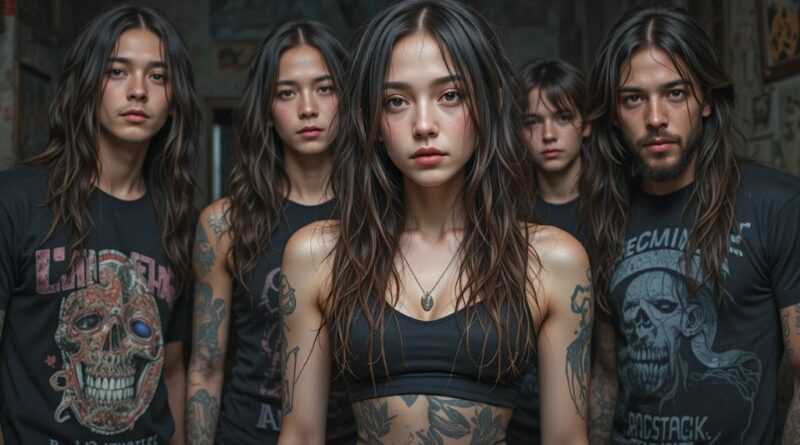How AI-Generated Music Is Quietly Infiltrating Your Playlists
A new breed of phantom artists is amassing millions of streams whilst human musicians struggle to be heard. Here’s how artificial intelligence is reshaping the music industry from the shadows.
The morning commute playlist starts with a familiar indie favourite, transitions into something that feels authentically vintage, then shifts to what sounds like a lost track from the 1970s psychedelic revival. But something’s not quite right about that third song. The production is too polished for lo-fi, the lyrics too perfectly crafted for spontaneity, and the band behind it? They might not exist at all.
Welcome to the age of AI-generated music infiltration, where algorithms don’t just recommend songs—they create them, complete with fictional band members, fabricated backstories, and carefully curated aesthetic profiles. The phenomenon reached a crescendo recently with The Velvet Sundown, a mysterious psychedelic rock act that amassed over 500,000 monthly Spotify listeners in mere weeks, despite having no verifiable online presence beyond their streaming profiles.
The Anatomy of a Digital Mirage
The Velvet Sundown represents the apotheosis of AI music sophistication. Their Spotify biography reads like purple prose generated by an overzealous chatbot: “The Velvet Sundown don’t just play music — they conjure worlds. Somewhere between the ghost of Laurel Canyon and the echo of a Berlin warehouse, this four-piece band bends time, fusing 1970s psychedelic textures with cinematic alt-pop and dreamy analog soul.”
The band’s supposed members—”mellotron sorcerer” Gabe Farrow, “free-spirited percussionist” Orion “Rio” Del Mar, “synth alchemist” Milo Rains, and guitarist Lennie West—exist nowhere on the internet beyond this carefully constructed mythology. No social media accounts, no concert footage, no interview clips, no childhood photos. They are digital phantoms with algorithmic souls.
Their tracks have been strategically placed in over 30 popular playlists created by anonymous curator accounts, and have begun appearing in users’ Discover Weekly recommendations, exploiting Spotify’s own algorithm to gain credibility through association with legitimate artists.
The Economics of Artificial Artistry
This isn’t merely a technological curiosity—it’s a business model with profound implications for working musicians. The first criminal prosecution of AI streaming fraud occurred in 2024, when Michael Smith orchestrated a seven-year scheme using artificial intelligence to generate massive fraudulent streaming revenue. The case highlighted how AI has become what industry experts call “the ultimate enabler” of streaming manipulation.
The mathematics are stark. If an AI system can generate hundreds of songs daily at virtually no cost, whilst real musicians spend months crafting a single album, the economic dynamics shift dramatically. Each stream that flows to an AI-generated track represents revenue diverted from human artists who depend on streaming income to survive.
The phenomenon extends beyond individual bad actors. Bands like The Devil Inside, with approximately 700,000 monthly listeners and a track with 1.6 million streams, have achieved Spotify verification despite bearing obvious hallmarks of AI generation. This suggests the problem has reached institutional scale, challenging streaming platforms’ ability to maintain the integrity of their ecosystems.
The Uncanny Valley of Sound
What makes AI-generated music particularly insidious is its increasing sophistication. Early artificial compositions were easily identifiable—stilted melodies, unnatural vocal inflections, and production that felt mechanical. Today’s AI music generators, particularly tools like Suno and Udio, produce tracks that inhabit an uncanny valley of authenticity.
The Velvet Sundown’s country-tinged psychedelic rock, for instance, demonstrates remarkable genre fluency. The tracks contain the characteristic tape saturation and analog warmth that listeners associate with authentic vintage recordings, complete with strategically placed imperfections that simulate the natural limitations of period recording equipment.
Yet closer examination reveals tell-tale signs: vocal phrases that repeat with algorithmic precision, guitar solos that follow mathematical rather than emotional progressions, and lyrics that demonstrate semantic understanding without genuine meaning. It’s music that sounds authentic whilst remaining fundamentally hollow.
Platform Proliferation and Detection Challenges
The infiltration extends across multiple streaming services, each grappling with the challenge of identifying and managing AI-generated content. Spotify, Apple Music, YouTube Music, and others face a technological arms race where detection systems must evolve as quickly as generation capabilities.
The scale of the problem is staggering. Industry estimates suggest thousands of AI-generated tracks are uploaded to streaming platforms daily, with only a fraction being detected and removed. The challenge lies not just in identifying AI-generated content, but in determining intent—is this artistic experimentation, commercial fraud, or something in between?
Some platforms have begun implementing labelling requirements for AI-generated content, but enforcement remains inconsistent. The lack of clear labelling has intensified debates about whether streaming services should be required to identify AI-generated songs, particularly when they achieve viral success.
The Human Cost
Behind the technological fascination lies a human story of displacement and devaluation. Independent musicians report their streams declining as playlists become saturated with AI-generated content that mimics their aesthetic at a fraction of the cost. The democratising promise of streaming platforms—that anyone with talent could find an audience—becomes hollow when “anyone” includes algorithms.
The psychological impact on artists cannot be understated. Musicians who have spent years developing their craft find themselves competing against systems that can generate stylistically similar content in minutes. The unique human experiences, emotions, and perspectives that traditionally drove musical creation become commoditised and artificially replicated.
Regulatory Responses and Industry Adaptation
The music industry’s response has been fragmented but increasingly urgent. Trade organisations are lobbying for clearer regulations around AI-generated content, whilst some labels are embracing the technology as a creative tool rather than viewing it as a threat.
The distinction between AI-assisted and AI-generated music has become crucial. Many artists now use AI tools for inspiration, arrangement, or production enhancement, blurring the lines between human and artificial creativity. The challenge lies in maintaining space for genuine human artistry whilst accommodating technological innovation.
Some proposed solutions include mandatory disclosure requirements, separate charting systems for AI-generated content, and revenue-sharing models that account for the reduced production costs of artificial music. However, implementation remains complex, particularly given the global nature of streaming platforms and varying regulatory environments.
The Future Soundscape
As AI music generation becomes more sophisticated, the fundamental question evolves from “Can we detect it?” to “Does it matter?” If AI-generated music provides genuine listening pleasure, some argue that its artificial origins become irrelevant. Others contend that music’s value lies precisely in its human origin—the shared experience of emotion, struggle, and creativity that connects artist to listener.
The Velvet Sundown phenomenon suggests we’re approaching a tipping point where AI-generated music doesn’t merely imitate human creativity but begins to define new aesthetic categories. Whether this represents evolution or invasion depends largely on how the industry chooses to adapt.
Conclusion: Navigating the New Musical Reality
The infiltration of AI-generated music into mainstream streaming platforms represents more than a technological curiosity—it’s a fundamental shift in how music is created, distributed, and valued. As algorithms become increasingly sophisticated at mimicking human creativity, the music industry faces unprecedented challenges in maintaining the integrity of artistic expression whilst embracing beneficial innovations.
The story of The Velvet Sundown serves as a cautionary tale about the ease with which artificial content can masquerade as authentic artistry. Yet it also highlights the remarkable capabilities of AI systems to create compelling musical experiences, raising profound questions about the nature of creativity itself.
As listeners, we face the choice of whether to care about the human origins of our musical experiences or to embrace a future where the source matters less than the sound. As an industry, music must grapple with protecting the livelihoods of human artists whilst allowing space for technological innovation.
The ghost in the machine isn’t just generating music—it’s forcing us to examine what we truly value in artistic expression. The answer will shape not just the future of music, but our understanding of creativity, authenticity, and human connection in an increasingly artificial world.
The conversation around AI-generated music continues to evolve rapidly. For the latest developments in this story, including responses from streaming platforms and regulatory bodies, readers are encouraged to follow ongoing coverage from music industry publications and technology news sources.
We’d love your questions or comments on today’s topic!
For more articles like this one, click here.
Thought for the day:
“It’s so difficult to describe depression to someone who’s never been there because it’s not sadness.” J.K. Rowling



